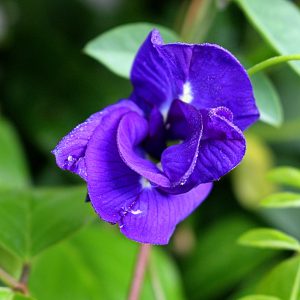
If you appreciate the color of a deep blue flower, look no further than that of the butterfly pea! This easy-to-grow vine can make a great trellis or post covering with the deepest blue flowers you may have ever seen.
A native to Southeast Asia, the butterfly pea (Clitoria ternatea) now grows across the world as a popular ornamental vine with the ability, like other legumes, to fix nitrogen in the soil with the help of certain bacteria. With delicate pea-like flowers of deep blue with a yellow throat, (there is also an all-white cultivar), the butterfly pea even comes in varieties featuring both single and double-flowers. Considered a short-lived perennial which can freeze back in the winter, the abundant seeds produced will often sprout and reseed as volunteers. Fine for sun or part-shade, this twining vine will seek out and wrap itself around a variety of supports which should allow for up to fifteen feet of vine. Also consider growing this flowering pea in hanging baskets where the vines will cascade over the side providing a fine plant for the summer.
Although it may freeze-back in the winter and/or just simply conk out, the butterfly pea is easy to grow from seed or even from cuttings. A butterfly pea can go from seed to flower in as little as six weeks. Soaking the seeds in water for a few hours prior to planting will help germination.
An additional benefit of the butterfly pea is its use as a food dye and a tea. In its home countries, color from the butterfly pea flowers is extracted to dye rice an exotic blue color. Tea can also be made from the flowers for a unique eye-catching beverage. The literature also notes that flowers, leaves, young shoots, and tender pods are all edible.
Unless a friend provides a few seeds for you to start, the butterfly pea is readily available in seed catalogs or, easily found via an Internet search. I especially like the double-flowering varieties which have extravagant petals and supersized flowers. While the butterfly pea does not really attract butterflies – it just looks like a butterfly to some – I have found it a welcome source of unique color on a manageable vine. For more information on all types of vining plants suitable for our area, or to ask a question, you can also call the Master Gardener Volunteer Helpdesk on Mondays, Wednesdays, and Fridays from 1 to 4 pm at 764-4340 for gardening help and insight into their role as an Extension volunteer. Ralph E. Mitchell is the Director/Horticulture Agent for UF/IFAS Extension – Charlotte County. He can be reached at 941-764-4344 or ralph.mitchell@charlottecountyfl.gov, Connect with us on social media. Like us on Facebook @CharlotteCountyExtension and follow us on Instagram @ifascharco
Resources:
UF/IFAS Gardening Solutions (2023) Butterfly Pea. The University of Florida Extension Service, IFAS.
Campbell, S. M., Pearson, B. & Marble, C. (2022) BUTTERFLY PEA (CLITORIA TERNATEA) FLOWER EXTRACT (BPFE) AND ITS USE AS A PH-DEPENDENT NATURAL COLORANT. The University of Florida Extension Service, IFAS.
Smith, M. L. (2022) Butterfly Pea – A Natural Food Coloring. The Pennsylvania State University Extension Service.
Clitoria ternatea (2016) https://en.wikipedia.org/wiki/Clitoria_ternatea.
 3
3
